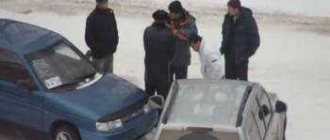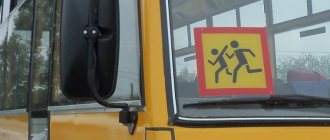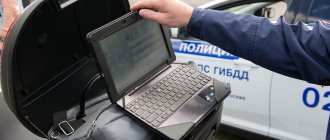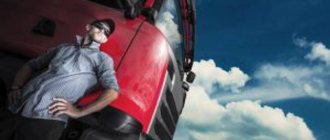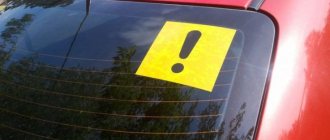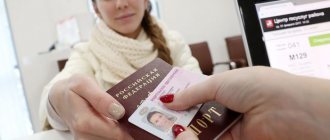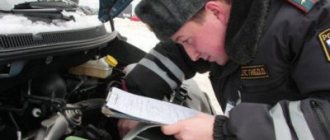Imagine the situation - you are driving a car to do your business. And suddenly traffic police officers appear in front of the car, slow down and start checking your license, insurance policy - everything is fine and you are about to drive on, and suddenly a traffic police officer asks you to open the trunk for inspection. What to do?
Naturally, you don’t have anything like that in it, and you, like a law-abiding citizen, lift the lid and present what is inside.
And it begins: where is your warning triangle, first aid kit and fire extinguisher? What lies here? Etc.
After these words, you begin to understand that you didn’t study the law in vain and are now frantically trying to remember at least something. We hope that the article below will help you avoid falling into similar situations.
Your actions: what should they be?
Let us immediately make a reservation that representatives of the inspection have the right to conduct either an inspection or search of the car. Let us explain the difference between these concepts. The inspection is visual, that is, when a traffic police officer walks around your car in a circle, checks the license plates and looks through the windows. That's all. This whole procedure is called a visual inspection.
But when you are asked to open the door of your “four-wheeled friend” to check the interior or luggage compartment, this is called an inspection. This means that the traffic police officer must present a documentary basis and two witnesses must be present at what is happening, plus a protocol must be drawn up.
If you start pointing this out to the inspector, he instructs you to find these witnesses yourself. Remember, it is his responsibility to look for witnesses. If the latter are not present, then the inspector must film the entire process.
Many traffic inspectors say to this: their actions are not an inspection, because they do not climb inside, but only look into the ajar door opened by you. It's still an inspection.
What to do if a police officer demands to see: a fire extinguisher, a warning triangle. Here, again, you need to go into the luggage compartment, so it turns out that you personally, voluntarily open it?
ATTENTION !!! Experts advise doing the following - announce to him that during the departure, all of the above items were in their places. But since he wants to make sure of this, then go ahead, please. But only under the protocol, in front of two witnesses or under a video camera. Or it will show you an article of law obliging you to do all this.
Otherwise, all his actions fall under the definition of arbitrariness. This is Art. 19.1 Code of Administrative Offences.
What to do if the inspector agrees to draw up a protocol? It’s okay, it’s his right, but again we repeat – he must find the witnesses and the video camera himself. In this case, passengers of your car or other traffic inspectors cannot act as witnesses. In addition, he must indicate in the protocol the reason for the search, and it must be compelling and supported by documents.
Sometimes, especially in the evening or at night, inspectors begin to drag their feet, because at this time on the road, especially outside a populated area, it is quite difficult to find witnesses.
In such a situation, we proceed as follows. We wait five minutes, after which we tell the officer who stopped you: if you are delayed further, you will call “02” and inform the officer on duty that the traffic police officer who stopped you is violating Art. 12.35 Code of Administrative Offences. This is an illegal restriction of the right to drive a car. The traffic policeman faces fines of up to 20 thousand.
IMPORTANT !!! Remember: the search should be carried out only in the direct presence of the car owner. The stopped policeman climbs into the passenger compartment or into the luggage compartment with his own hand, then the latter must be informed that such steps of his will be reclassified as a search, and this is a completely different article that requires judicial permission for this. If he wants to move something in the luggage compartment, he must ask you to do this.
During the inspection, some inspectors ask to show them what is in their bags and pockets. The law qualifies: “personal search” (see Article 27.7 of the Administrative Code). Two witnesses are required; remember, they must be the same gender as the driver. There is a girl driving, and the said search is carried out by an employee of her gender. With the preparation of a personal search protocol.
How to respond to a request
Let's imagine that a traffic police officer asks you to open the trunk. How to act in such a situation? This is a representative of the law. Disobeying him is dangerous. This could lead to trouble.
There is no need to be afraid. If the inspector asks you to open the trunk, then you need to do the following:
- require a protocol to be drawn up;
- stop 2 witnesses;
- or film everything on camera.
So is the driver obliged to open the trunk to the traffic police inspector? No. His request means nothing.
To look into the luggage compartment, you need a security clearance. Plus the witnesses in front of whom this happens.
But a cunning employee may say that this is just an inspection, not an inspection. And here he is disingenuous. You too will cheat.
The inspection involves a visual check of the car from the outside, as well as examination of the interior through the windows. All. This is the maximum authority during inspection.
Are the inspectors ignoring legal requirements?
Sometimes policemen do not pay attention to the driver’s requirements to comply with the law and begin to inspect the vehicle without recording it or inviting witnesses. He himself opens the doors, the luggage compartment, rummages in the purse, and demands that the pockets be turned out. Lawyers advise doing the following - call 102 and declare: an illegal search is being carried out in your car.
But remember: you should not interfere with the policeman in his actions. Especially standing in his way, offering physical resistance. Remember, the law can turn against you.
IMPORTANT !!! The best way out is to videotape everything that happens, since modern gadgets allow you to do this. Moreover, video footage serves as excellent evidence of police misconduct.
If possible, try to attract witnesses. They can also serve as passengers in your car. You can even attract passing pedestrians or try to stop passing cars.
After which you have ten days to appeal the employee’s actions. Your video recording and witness statements must be attached to the complaint.
Emergency sign, first aid kit, fire extinguisher. Or how to force someone to voluntarily open the trunk?
In response to a verbal demand or request to open the doors, hood or trunk of the car, the owner must politely refuse and ask to file a protocol and clarify the reason for the search.
However, experienced traffic police inspectors are also subtle psychologists and, in some cases, ask to show them a first aid kit, a fire extinguisher or a warning triangle. What to do in such cases?
Professional drivers and experienced car enthusiasts advise not to panic and not strive to fulfill such a request as soon as possible.
After such a request, you should clearly and calmly explain that all the necessary accessories were in the car when you left home and, of course, are there now. However, to conduct an inspection, the law enforcement officer needs to complete a number of formalities. And only then will you open the trunk.
It should be remembered that there is no article according to which the driver must present a first aid kit or fire extinguisher to traffic police officers, which means that the requirement to show them is unlawful and can be challenged in court.
What does the law say? Are we studying legislation?
The complexity of the situation is as follows - our legislation does not contain a clear definition of these concepts: “inspection”, “inspection”, although they are described. Therefore, below we indicate extracts from several articles with the help of which you can save yourself from the arbitrariness of the traffic inspector.
Article 27.9. The Administrative Code states the following:
- In case of inspection of a vehicle, it is carried out without changing its design.
- The task is to discover the instruments for committing the offense.
- This type of activity can be carried out by persons specified in the Code of Administrative Offenses - 27.2, 27.3. if there are two witnesses at the time of inspection.
- The presence of the person driving the vehicle during the inspection or search by police officers is mandatory. There is an exception - circumstances do not tolerate delay, then it is allowed to carry out the specified activity without a person driving the vehicle;
- Taking photographs and video recording is allowed;
- Mandatory recording in the presence of witnesses. It should indicate the location of the inspection, information about the driver, and the car.
Does the inspector have the right to inspect the trunk?
It is necessary to distinguish between two concepts that are used in the Administrative Code - inspection and search.
The inspection of the vehicle is carried out without the participation of witnesses, as well as a protocol. The car is inspected from the outside; the car owner is not required to open the doors, glove compartment, or trunk.
Inspection - carried out when search activities are carried out. A law enforcement representative can legally inspect the trunk and interior.
Important! During the inspection, patrol officers are prohibited from inspecting personal belongings and pockets. There is a specific procedure for this.
For the inspection, two witnesses are brought in (outsiders; patrol officers cannot act as witnesses), a protocol is drawn up and video recording is carried out. In the event of a state of emergency being declared, the traffic police inspector has the right to disregard witnesses and the protocol. Any actions that do not comply with these standards are considered illegal.
Legal grounds for conducting an inspection
There are several legal grounds for inspection.
- Presumably the vehicle has been stolen or is being driven by persons who have committed a crime. In such a situation, at all traffic police posts there are directions with a description of the car. If a crime is classified as particularly serious, roads are blocked and all cars are searched, but for this there must be an order from the Ministry of Internal Affairs.
- Refusal of a vehicle driver to undergo a voluntary inspection.
- The traffic police officer presents the driver with an orientation.
- The assumption that a weapon is being transported in the car, evidence indicating a crime.
Advice! When a traffic police representative insists on an inspection, he is obliged to justify his demand.
How to behave?
Many drivers, having met with a traffic inspector, begin to fuss for no reason and ingratiate themselves. Traffic police officers immediately react to such behavior by the driver - after all, in their opinion, if a person is not guilty, then he does not worry. And they begin to insist on inspection.
ATTENTION !!! Therefore, behave confidently, do not shy away, do not ingratiate yourself, and do not become overly excited. On the contrary, show that you are persistent and principled. Let some “metal” into your voice.
Usually in such cases, inspectors retreat, because a conflict with a confident person can lead to unpredictable consequences. After all, the driver’s guilt has not been proven, and the inspector’s premonitions cannot be attached to the protocol.
Sometimes during an inspection, inspectors begin to attack the driver, saying that it is impossible to find the body number plates or they are dirty. And the driver must either find them and show them to the employees so that they can check them with what is written in the car documents. And if they are dirty, then clean them.
So, you don’t have to do all this. If the work surface is dirty, let him clean it himself. And you don't have to know where they are located. After all, it was registered by his colleagues from the MREO, so let him call them and find out.
In 2021, there are no articles in the laws obliging the person driving the vehicle to present a fire extinguisher or other items for inspection.
When they ask to see a fire extinguisher and first aid kit
You already know what to do if a traffic cop asks you to open the trunk. He could not confuse you in the concepts of search and inspection.
But he goes to the last. If so, then he demands to show a fire extinguisher, a first aid kit, and an emergency sign. To do this, you need to open the trunk. How to be.
It's simple. Say that when you left home or work, all this was in the trunk. If he wants to check, then he needs a protocol, as well as witnesses. There is no law requiring these items to be shown when requested by an employee.
What should drivers not do?
The World Wide Web and television broadcasts show footage of police officers starting to break car windows and pull the person behind the wheel out of the window. And everyone around is talking about the unlawful actions of the police. They do not pay attention to the actions that preceded this event.
The thing is that people driving on the roads want to increase their rating on various social networks. It is precisely those citizens who begin to actively defend their rights. This is expressed by wild screams in the face of a police officer. And he hadn’t even had time to introduce himself yet. Do not be like such individuals, obey the law and be prudent. And in difficult situations requiring special knowledge and experience, our lawyers are always ready to provide you with qualified legal assistance.
Car inspection procedure
- the policeman announces that he intends to conduct a search and asks everyone to leave the cab;
- witnesses are brought in with identification cards, their rights and obligations are explained to them (or video recording is done with a certified camera);
- an inspection protocol is drawn up, which includes information about all participants, as well as how the event is recorded;
- the inspector asks the driver to open the trunk of the car in the presence of all involved persons;
- The traffic cop does not have the right to inspect the contents of bags, but he can lift and rearrange them;
- All information based on the survey results is entered into the document, it is signed by the participants and a copy is given to the driver.
How to properly tow with a rigid or flexible hitch - what do the traffic rules say?
If a police officer does not comply with this procedure, then his actions are illegal and can be appealed in court.
But at the same time, the driver is prohibited from opposing the inspector, speaking towards him in a disrespectful manner or threatening him. This behavior may result in a fine as punishment for a misdemeanor or crime.
Inspection protocol
If the motorist voluntarily agrees to search the trunk, the police officer may refuse to draw up a search report. Therefore, if you want to have an official document, then the traffic cop must be required to follow the procedure from the very beginning.
Inspection protocol forms may not be numbered. In fact, the inspector has the right to write such a document by hand, entering into it all the information specified in the recommended form approved by order of the Ministry of Internal Affairs of the Russian Federation No. 664 dated August 23, 2017.
If information about the results of the search is included in the driver’s administrative violation protocol, then this protocol must be numbered and it must be filled out only by an authorized person.
What to do if a police officer does not comply with the law
The most common cases of arbitrariness of the traffic police during inspections:
- refusal to involve witnesses;
- use of illegal means of video recording;
- failure to draw up procedural documents on the actions taken.
Less common are such egregious cases as the use of physical force, being taken to the police station and the car being seized.
What to do if a police officer refuses to work with witnesses:
- try to record your conversation with the inspector on a video camera or voice recorder;
- inform him that if he does not stop his illegal actions, you will complain to the prosecutor’s office;
- comply with all requirements of the inspector;
- attract witnesses and record their information;
- call the prosecutor's office hotline to report a violation.
Rights of road users – what are the responsibilities of pedestrians and drivers?
The same actions must be carried out in case of other manifestations of arbitrariness on the part of a traffic police officer.
